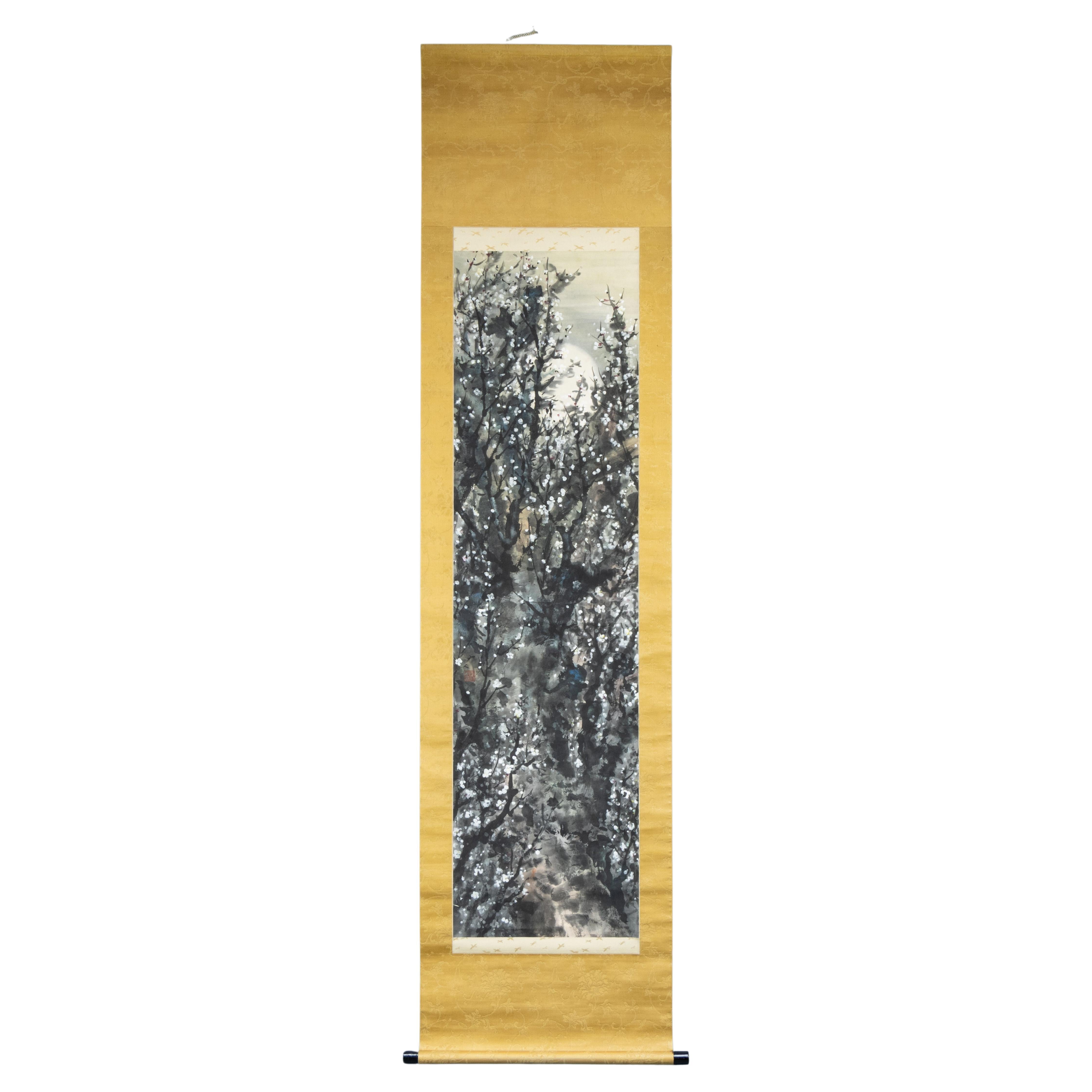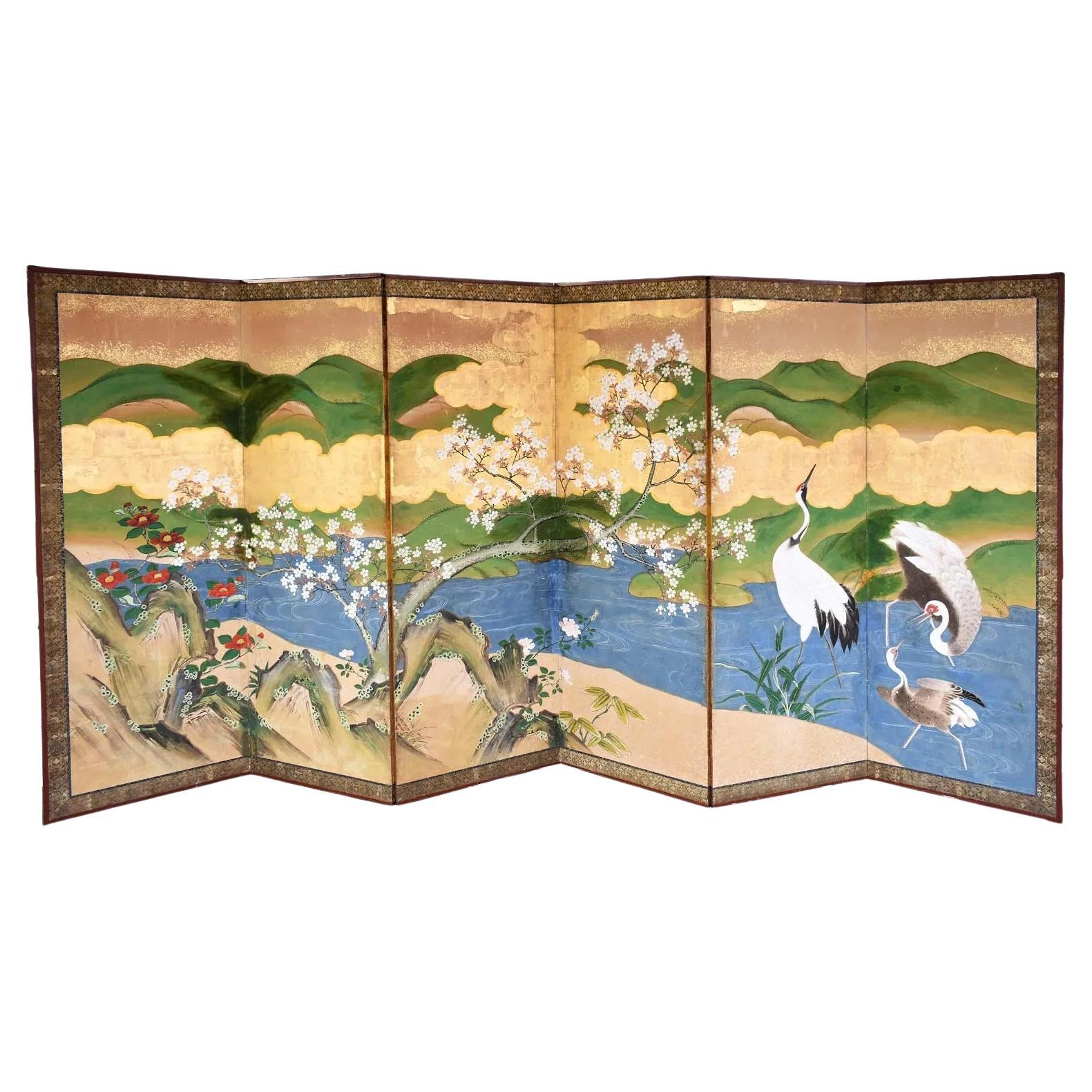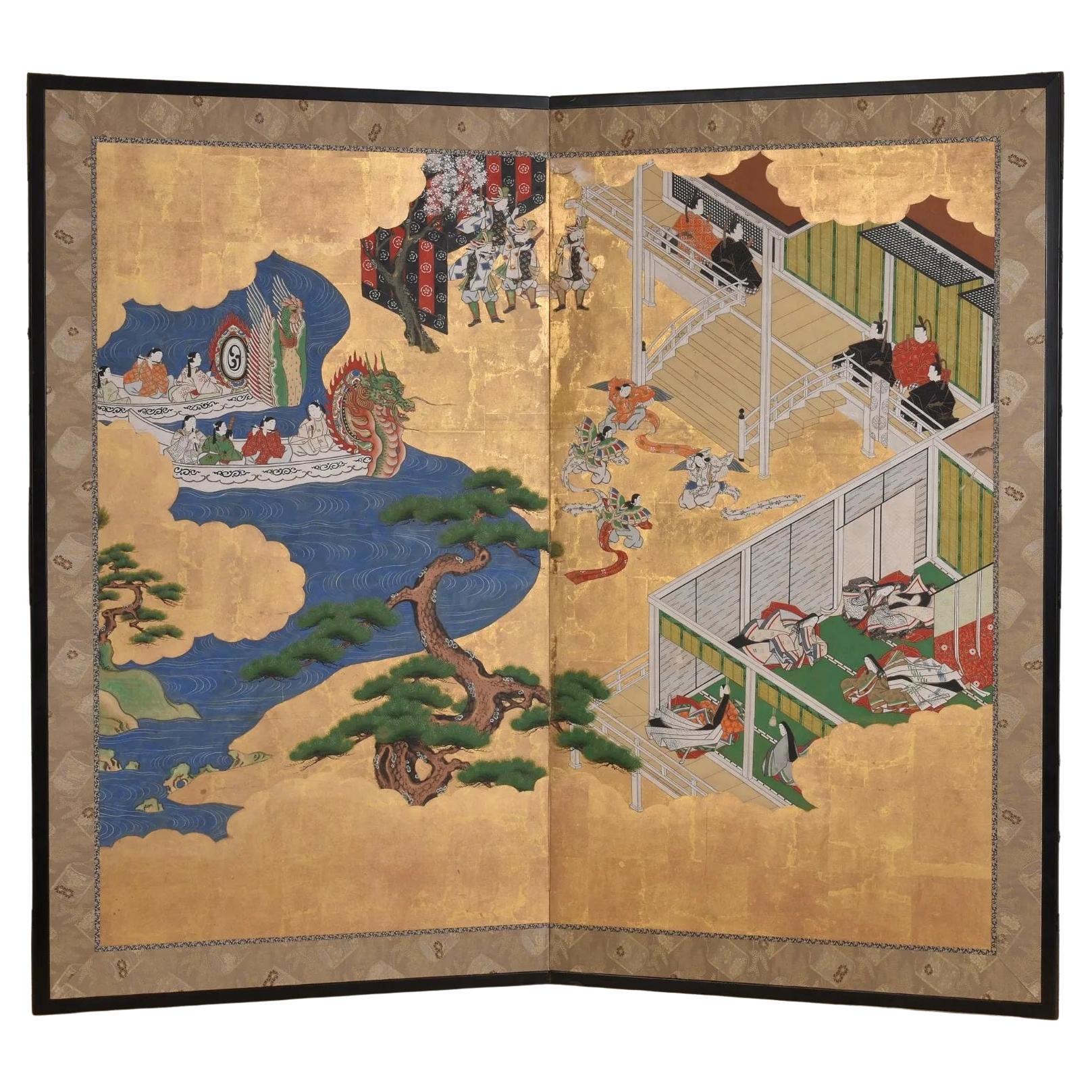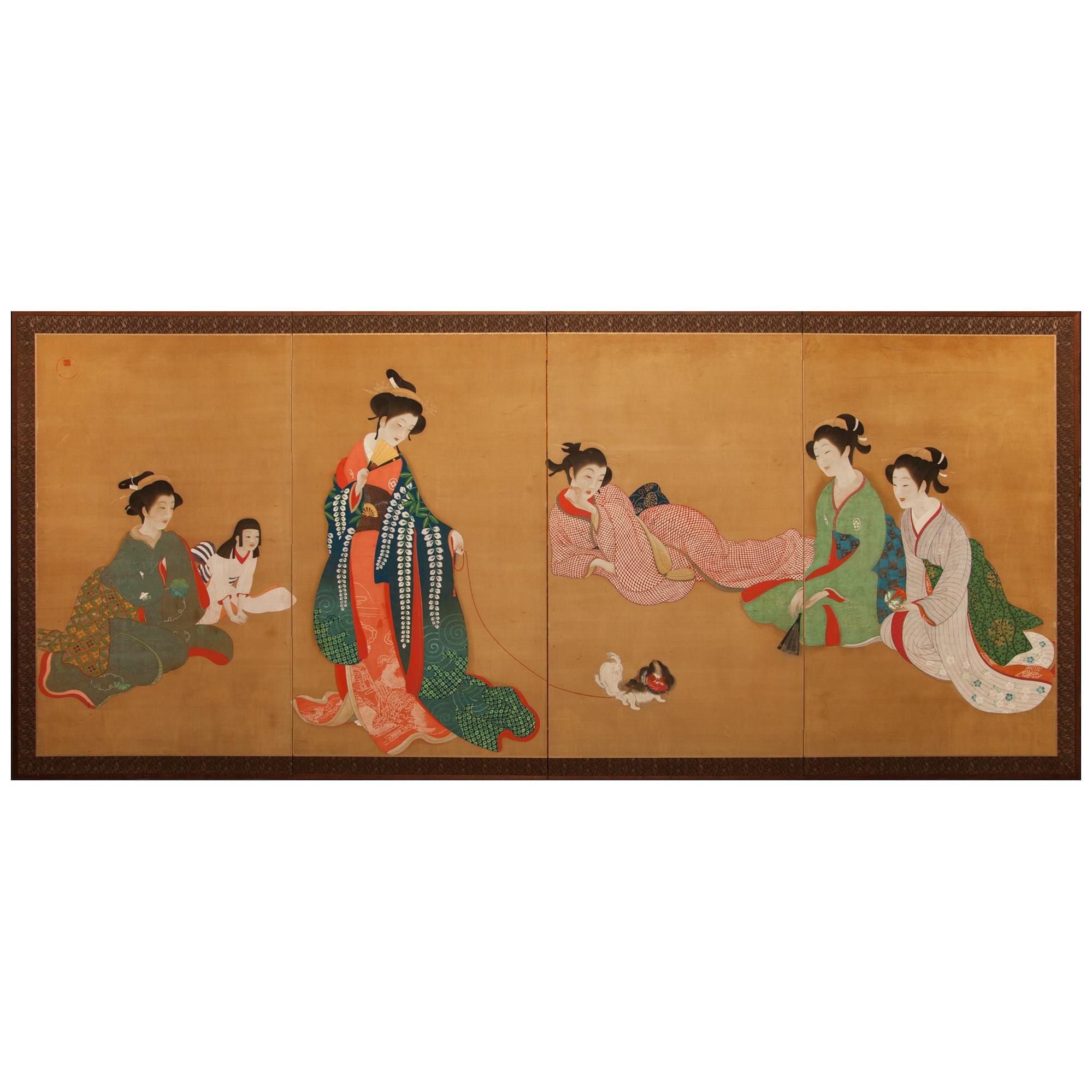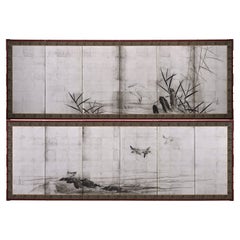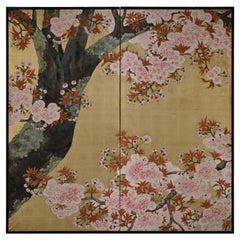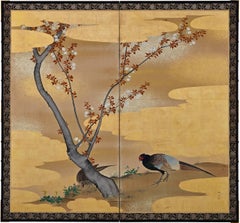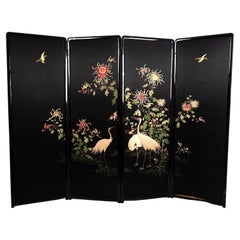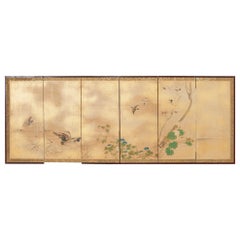Items Similar to Circa 1900 Japanese Screen. Cherry Blossoms in Moonlight. Meiji period.
Want more images or videos?
Request additional images or videos from the seller
1 of 7
Circa 1900 Japanese Screen. Cherry Blossoms in Moonlight. Meiji period.
About the Item
Kobayashi Shosen (1877-1946)
Cherry Blossoms in Moonlight
Six-panel Japanese Screen. Ink, color and gofun on paper.
The image depicts a stunning scene captured on a six-panel Japanese folding screen from the Meiji period. Commanding the center is a massive tree trunk belonging to a blooming cherry blossom tree, its horizontal span emphasizing its grandeur. The tree’s delicate blossoms are illuminated by the soft light of a rising full moon peeking from behind the trunk. The entire scene is bathed in the ethereal glow of the moonlight, casting a serene atmosphere. Blustery winds swirl through the air, causing cherry blossom petals to dance and drift gently across the scene. The artwork, rendered in the Japanese nihon-ga style of the turn of the century, features soft colors and subtle ink wash techniques, with light hues accentuating the delicate beauty of the flower petals. The trunk serves as a natural divider between the foreground and background, creating a sense of depth and perspective within the painting. The image captures the tranquility and ephemeral beauty of a moonlit cherry blossom night in Japan.
Cherry blossoms or sakura hold profound significance in Japanese culture, weaving intricate layers of meaning in literature, poetry, and art. Their brief blossoming period often parallels the transient beauty of existence. ‘Mono no aware’ is a Japanese phrase that encapsulates the delicate emotions evoked by the subtle nuances of life and the changing seasons. In this scene the moon's luminous presence and the gentle fall of cherry blossoms evoke a profound sense of mono no aware, inviting contemplation of life's fleeting moments.
Kobayashi Shosen, born in Atsuta, Aichi Prefecture in 1877, embarked on his artistic journey under the tutelage of Hattori Sekisen from the Shijo school. Upon relocating to Tokyo, he honed his craft under the guidance of Kawai Gyokudo. Seeking to further refine his skills, he pursued studies with Takeuchi Seiho in Kyoto. Throughout his career, Shosen showcased his talent through depictions of shrines, temples, flowers, and birds. Renowned for his mastery in painting sparrows, he earned a reputation as a foremost artist in this genre. In his later years, he transitioned to a lighter and more stylish painting style characterized by reduced brushstrokes, earning widespread acclaim for his skillful use of negative spaces. Amidst the turmoil of war, he found refuge in Gifu prefecture and passed away in Nakatsugawa city in 1946.
- Dimensions:Height: 68.5 in (173.99 cm)Width: 145 in (368.3 cm)Depth: 0.75 in (1.91 cm)
- Style:Meiji (Of the Period)
- Materials and Techniques:
- Place of Origin:
- Period:
- Date of Manufacture:Circa 1900
- Condition:Refinished. Wear consistent with age and use. The screen has been furnished with a new black lacquered frame and new backing paper.
- Seller Location:Kyoto, JP
- Reference Number:1stDibs: LU2472338838512
About the Seller
5.0
Recognized Seller
These prestigious sellers are industry leaders and represent the highest echelon for item quality and design.
Gold Seller
These expertly vetted sellers are highly rated and consistently exceed customer expectations.
Established in 2001
1stDibs seller since 2016
67 sales on 1stDibs
Typical response time: 3 hours
- ShippingRetrieving quote...Ships From: Kyoto, Japan
- Return PolicyA return for this item may be initiated within 10 days of delivery.
Authenticity Guarantee
In the unlikely event there’s an issue with an item’s authenticity, contact us within 1 year for a full refund. DetailsMoney-Back Guarantee
If your item is not as described, is damaged in transit, or does not arrive, contact us within 7 days for a full refund. Details24-Hour Cancellation
You have a 24-hour grace period in which to reconsider your purchase, with no questions asked.Vetted Professional Sellers
Our world-class sellers must adhere to strict standards for service and quality, maintaining the integrity of our listings.Price-Match Guarantee
If you find that a seller listed the same item for a lower price elsewhere, we’ll match it.Trusted Global Delivery
Our best-in-class carrier network provides specialized shipping options worldwide, including custom delivery.More From This Seller
View AllMeiji Era, Circa 1900 Japanese Screen Pair, Flowers & Birds of Spring & Autumn
Located in Kyoto, JP
Flowers & Birds of Spring and Autumn
Unknown artist.
Japan. Meiji period, circa 1900.
A pair of six-fold screens. Ink, color, gofun and gold leaf on paper.
Signed: Gaga S...
Category
Antique 1890s Japanese Meiji Paintings and Screens
Materials
Gold Leaf
Japanese Silver Screen Pair, Meiji Period, Herons & Plovers, Shijo School
Located in Kyoto, JP
Heron & Plovers
Ink and silver leaf on paper
Maekawa Bunrei (1837-1917)
A pair of low six-panel Japanese screens by Maekawa Bunrei, a later master of the Kyoto based Shijo school of painting. On the right screen a solitary white heron stands motionless in a stream. On the left screen plovers play along a shoreline. The elegant forms are executed employing fluid, minimalistic ink brushstrokes. The soft brushstrokes and the sharp light of the silver leaf lend the scenes a sense of translucence. The sophisticated composition superbly exploits the long, horizontal pictorial surface of the pair of folding screens...
Category
Antique Early 1900s Japanese Meiji Paintings and Screens
Materials
Silver Leaf
Early 20th Century Japanese Cherry Blossom Screen by Kano Sanrakuki
Located in Kyoto, JP
Cherry Blossoms
Kano Sanrakuki (1898-1981)
Showa period, circa 1930
2-panel Japanese Screen
Color, gofun and gold leaf on paper
Against a backdrop of gold-leafed ground, the lichen covered trunk and branches of the life-sized cherry blossom tree reach out and beyond the confines of the pictorial surface. The overall composition has a feeling of flatness which draws emphasis to the surface and the three-dimensionality of the cherry blossoms. Painstakingly built-up layers of thickly applied shell-white gofun detail the voluminous blossoms and cover large areas of this tour-de-force of Japanese Nihonga painting. By simplifying the background, minimizing the number of colors and depicting the blossoms with such heavy relief, the artist has emphasized the stunning presence of the cherry tree. The type of tree depicted is the Yae-Zakura; a double-layered type of cherry blossom famed for its beauty and strength. When we think of Japanese cherry blossoms, the first thing that comes to mind is Somei Yoshino variety, which has a single flower with five almost white petals. This type is fragile and easily blown away by strong wind or rain. Most of the double-flowered cherry blossoms begin to bloom when the Somei-Yoshino falls, and the flowering period lasts longer than that of the Somei-Yoshino.
Kano Sanrakuki originally studied painting at the Kyoto City Arts and Crafts School under the tutelage of Yamamoto Shunkyo...
Category
Early 20th Century Japanese Showa Paintings and Screens
Materials
Gold Leaf
Early 19th Century Japanese Screen. Cherry Blossom & Pheasants by Mori Tetsuzan
Located in Kyoto, JP
Mori Tetsuzan (1775-1841)
Pheasants and Cherry Blossoms
Two-fold Japanese screen. Ink, color, gofun, gold and silver on paper.
A two-fold Japanese bir...
Category
Antique Early 19th Century Japanese Edo Paintings and Screens
Materials
Gold Leaf
Japanese Screen Pair, Tigers by Kishi Renzan, Late Edo Period
Located in Kyoto, JP
Kishi Renzan (1804-1859)
Tigers
Pair of six-panel Japanese screens.
Ink and gold-leaf on paper.
In this monochromatic pair of six-fold Japanese screens painted on gold-leaf, Kishi Renzan has created a breathtaking composition of a family of tigers. The screens are filled with a sense of drama which is conveyed by both the subject matter and the wet, expressive brushwork. The running mountain stream and the towering waterfall allude to refreshment during the summer months and we feel the tiger families familiarity and security within their environment. Renzan’s master, Kishi Ganku...
Category
Antique Mid-19th Century Asian Edo Paintings and Screens
Materials
Gold Leaf
Circa 1950 Japanese Screen. Surrealist Nihon-ga Landscape.
Located in Kyoto, JP
Anonymous
Surrealist Landscape
Showa era, circa 1950
Four-panel Japanese Screen, pigment on paper.
A post World War 2 Japanese nihon-ga screen de...
Category
Mid-20th Century Japanese Showa Paintings and Screens
Materials
Paper
You May Also Like
Antique Japanese Meiji Period Silk Embroidered Screen Room Divider Byobu C.1900
Located in London, GB
Antique Japanese Meiji period silk embroidered screen /room divider Byobu C.1900 Kyoto, Japan.
Silk embroidered satin lacquer framed panels....
Category
Antique Early 1900s Japanese Meiji Paintings and Screens
Materials
Silk, Lacquer
$14,171 Sale Price
20% Off
Japanese Meiji Period Painting by Shôjin Nishimura , Plum tree in Moonlight
Located in Amsterdam, Noord Holland
Very Lovely painting.
Category
Antique Mid-19th Century Japanese Meiji Paintings and Screens
Materials
Silk
$1,107 Sale Price
20% Off
Vintage Meiji Period Six Panel Japanese Folding Screen
Located in Locust Valley, NY
A super chic and beautifully done Vintage Meiji Period Six Panel Japanese Folding Screen Depicting Cranes in Continuous Landscape With Blossoming Foliage...
Category
Mid-20th Century Unknown Meiji Paintings and Screens
Materials
Brass
Japanese Meiji Period Six Panel Screen Ducks in Water Landscape
Located in Rio Vista, CA
19th century Japanese Meiji period six-panel screen depicting a serene water landscape with ducks and songbirds amid Momiji (red maple) hibiscus, and morning glory. Made in the Nihon...
Category
Antique 19th Century Japanese Meiji Paintings and Screens
Materials
Silk, Wood, Paper
Japanese Meiji Period Two Panel Screen
Located in Stamford, CT
Japanese Meiji Period (1868-1912) two-panel painted screen with various Tale of Genji scenes - ink, colors and gold leaf on paper.
Category
Antique 1870s Japanese Paintings and Screens
Materials
Paper
Meiji Period Japanese Four Panel Screen Bijin At Leisure
Located in Hudson, NY
Japanese four panel screen: Bijin At Leisure. Ladies in a tea house with a small dog. Seal reads "Ensan dai" (drawn by Ensan). Meiji Period (1868 - 1912) pa...
Category
Antique Late 19th Century Japanese Meiji Paintings and Screens
Materials
Silk, Wood
Recently Viewed
View AllMore Ways To Browse
Japan 1900
Cherry Blossom
Hand Painted Blossom
Japanese Cherry
Japanese Weaving
Antique Japanese Light
Cherry Painted Furniture
Horizontal Japanese
Temple Flower
Asian Paintings Of Birds
Meiji Panel
Japanese Meiji Panel
Cherry Artist
Antique Style Lighter
Hand Painted Japanese Screen
Paper Folding Screen
Antique Hone
Asian War

